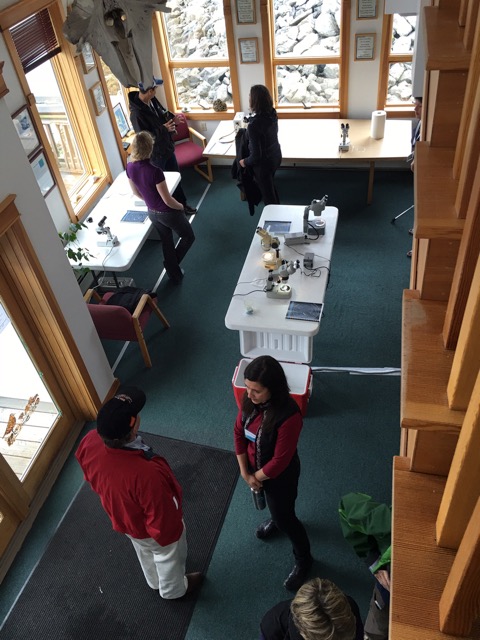Rasmuson Foundation Returns to Cordova

At the end of June, staff and board members of the Rasmuson Foundation visited the Prince William Sound Science Center to try their hands at research techniques used by our scientists. After Science Center CEO and President, Katrina Hoffman, offered a brief welcome, the group dove right in. They practiced throwing a cast net, analyzed plankton under the microscope, discovered marine invertebrates and learned about the acoustic devices used in the Ocean Tracking Network.

Staff and Board members from the Rasmuson Foundation learn how to throw a cast net. Photo credit: Aleesha Towns-Bain
The Rasmuson Foundation has generously supported an array of past and present Science Center research projects crucial to monitoring the rich waters on which we all depend. In 2015, the Rasmuson Foundation helped the Science Center purchase new technology that drastically improved the efficiency of measuring nutrients in the waters in both Prince William Sound and the Copper River. Just as gardeners benefit from knowing the content of their soil, oceanographers benefit from knowing the nutrient content of the waters they study, as certain nutrients like nitrate can limit or bolster growth of tiny plants in the water called phytoplankton. Because phytoplankton are the base of most marine food webs, these measurements ultimately allow scientists to gain insight into the productivity of our marine ecosystems, which affects everything that swims—from humpback whales to Copper River salmon. With help from the new technology, the Analytical AutoAnalyzer3 (AA3), Science Center oceanographer, Dr. Rob Campbell and his technicians can condense a year’s worth of nutrient analysis into just three weeks. Researchers have already processed over a couple thousand water samples, and these measurements continue to maintain a valuable record of the nutrient content in our aquatic ecosystems.
In 2014, the Rasmuson Foundation contributed to help Science Center ecologist Dr. Mary Anne Bishop work toward answering an important question—where do the cod go in the winter? Pacific cod, Gadus macrocephalus, typically migrate between their summer

Science Center ecologist, Dr. Mary Anne Bishop, shares information about acoustic devices used in Ocean Tracking Network. Photo credit: Aleesha Towns-Bain
feeding grounds and their winter spawning grounds, which sometimes involves swimming over 100 miles. Researchers wonder, however, whether Pacific cod in Prince William Sound migrate at all, as they seem to forage and spawn in the same region, which would make them ‘residents’ of the Sound. To solve this mystery, researchers inserted acoustic tags into a large sample of Pacific cod, and have used these tags to follow their locations. The tags emit ‘ping’ sounds every 2-3 minutes, which are recorded by 36 listening stations set up in Prince William Sound. By understanding the migrations and overall ecology of Pacific cod, this research will inform sustainable resource management of this species.
The Rasmuson Foundation has supported other Science Center research and outreach
activities as well. For example, in 2012 the Science Center purchased essential lab equipment, and in 2011, built a cabin that is now used to support Science Center summer camps, visiting college groups, trail crews and more.
A huge thanks to the Rasmuson Foundation for continuing its tradition of investing in Alaska and for supporting our mission to advance understanding and sustainable use of ecosystems in the northern Gulf of Alaska region.





